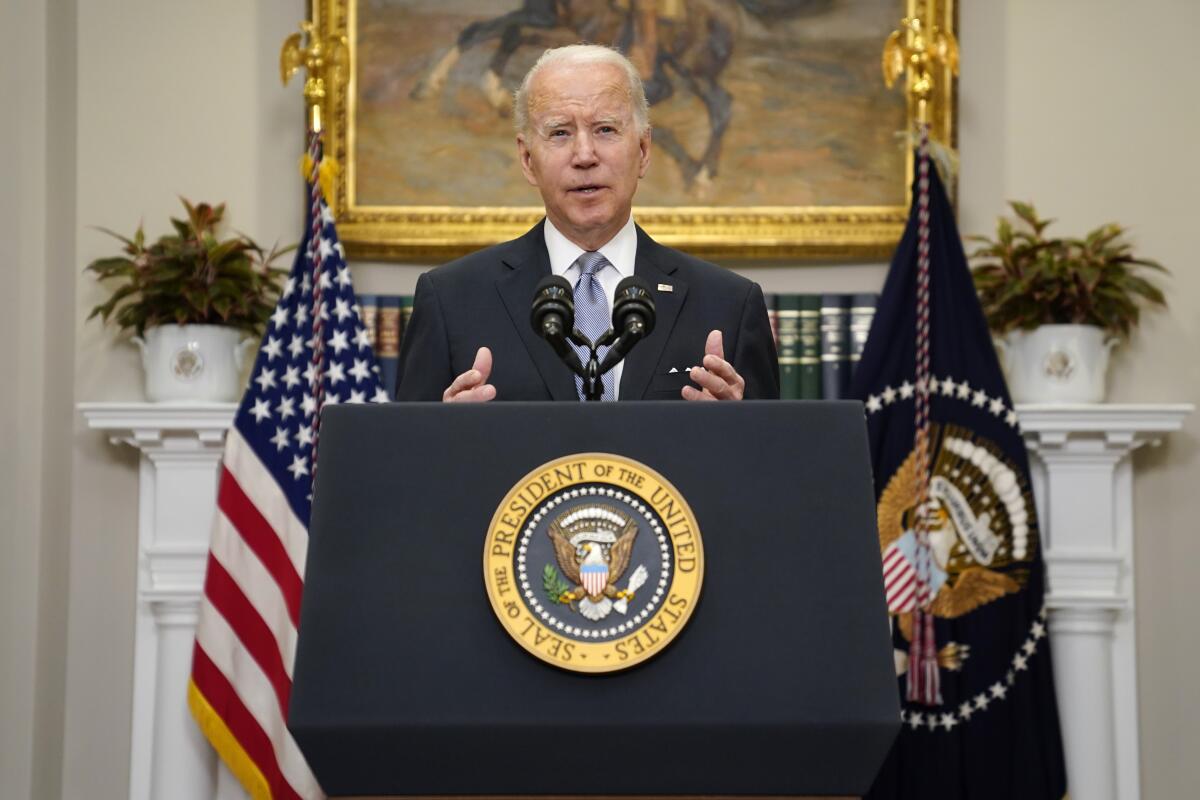Biden’s escalating aid to Ukraine reflects a sea change in U.S. foreign policy

- Share via
WASHINGTON — When President Biden took office last year, he had three top foreign policy priorities: to revive NATO and other alliances that President Trump had savaged, to withdraw the last American troops from Afghanistan, and to compete more effectively with a newly assertive China.
Russia, a declining power, seemed almost an afterthought. All Biden wanted from Moscow, he said last year, was “a stable, predictable relationship.”
The House will be more proportionate by some measures, but also more partisan and even more prone to gridlock.
Vladimir Putin had other ideas. Two months ago, Putin invaded Ukraine — and the result has been not only a tragic war, but a sea change in U.S. policy.
The struggle for Ukraine is now Biden’s main national security focus. The United States and Russia appear locked in a long-term confrontation reminiscent of the 20th century’s Cold War. The challenge of China is still out there, but strategists who hoped to shift U.S. troops from Europe to Asia have put those plans on hold.
Last week, Biden announced that he was sending an additional $800 million in military aid to Ukraine, bringing the total over the last two months to more than $3 billion. More important than the dollar figure were the weapons included: heavy artillery, helicopters, armored personnel carriers, antiaircraft radar systems and the Phoenix Ghost, a new kamikaze attack drone.
The shopping list reflected a gradual escalation since the opening weeks of the war, when Biden and his aides emphasized the limits of what the United States was willing to do — in part to avoid risking direct conflict between Russian forces and the North Atlantic Treaty Organization.
There would be no boots on the ground, they said, no long-range offensive weapons, and no U.S.-enforced “no-fly zone” to stop Russia’s air force from bombing Ukrainian cities. Nor would the United States agree to move MiG-29 aircraft from Poland through Germany to Ukraine.
Ukrainian President Volodymyr Zelensky and American hawks complained, but last week, Zelensky said the new aid package was “just what we were waiting for.”
What changed? As Ukraine’s armed forces performed better than expected — and Russia’s performed worse — the administration’s commitment to Kyiv deepened.
“Our policy is unequivocal that we will do whatever we can to help Ukraine succeed,” Biden’s national security advisor, Jake Sullivan, said in a TV interview. “At the end of the day, what we want to see is a free and independent Ukraine [and] a weakened and isolated Russia.”
The administration’s attitude was also hardened, he added, by “what the Russians have done, frankly — killing civilians, atrocities, war crimes.”
More broadly, Biden’s commitment to Ukraine appears to signal the end of a period of retrenchment in which Presidents Obama and Trump sought to disengage from the military entanglements launched by President George W. Bush.
Columbia University scholar Stephen Sestanovich has long argued that U.S. foreign policy tends to alternate between cycles of assertive international engagement, which he calls “maximalism,” and retrenchment.
“What puts an end to retrenchment is almost always some sort of shock,” he told me last week, something that “makes people think that downsized policies, however desirable they might have seemed a few years earlier, just won’t cut it in a more dangerous world.”
“Putin’s war has been exactly that sort of mind-focusing stimulus, and its effects are likely to be lasting ones,” he said.
If he’s right, the broader effects of the Ukraine crisis could include a Cold War-style division of the world into two blocs, one led by the United States, the other by China and Russia; long-term pressure from Congress for higher defense spending; and perhaps even a modest revival of bipartisanship in foreign policy.
Those trends will all feel familiar to Biden, who served on the Senate Foreign Relations Committee during the last half of the Cold War. A year or two ago, his fondness for NATO and other traditional U.S. alliances may have sounded like a throwback, but it has come in handy now.
He and his aides worked to focus NATO on Putin’s threats long before the invasion, enabling the alliance to impose coordinated sanctions as soon as the tanks rolled. His old-fashioned return to alliance-building turned out to be exactly what the West needed.
Biden’s foreign policy has been far from perfect. His withdrawal from Afghanistan, to take only the most painful example, was a fiasco.
But in Ukraine, at least, the president’s experience and instincts have served him well.
More to Read
Get the L.A. Times Politics newsletter
Deeply reported insights into legislation, politics and policy from Sacramento, Washington and beyond. In your inbox three times per week.
You may occasionally receive promotional content from the Los Angeles Times.












